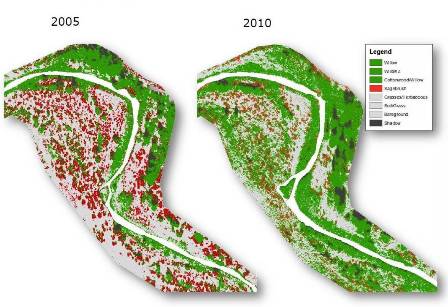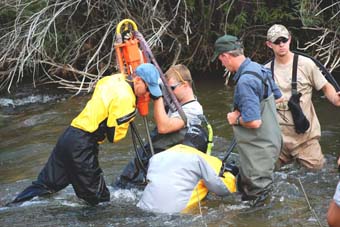November 2014: Research continues to substantiate the effectiveness of habitat restoration.Here's an update on what we're discovering about habitat restoration and fish survival.
September 2013: An expanding body of research is demonstrating the ecological importance of estuary habitats to salmon and steelhead. Read a digest of the latest findings and access the report here.
August 2013: A summary of results of tributary habitat research, monitoring and evaluation over the past five years shows that habitat improvements in the Columbia Basin are targeting and addressing degraded conditions and that fish are responding through increased survival, density and abundance.
The tributary habitat component of the BiOp focuses on 18 priority populations of salmon and steelhead whose growth and survival are limited by the quantity and/or quality of tributary habitat available. The BiOp calls for extensive habitat restoration where these populations spawn and rear, addressing key factors that limit their growth and survival.
The widely recognized positive relationship between habitat quality and fish survival provides the foundation for this approach. The relationship has been widely described in the scientific literature through studies of previous habitat actions,correlations between habitat improvements and fish survival and continuing research, much of it described in this report.
The increased survival attributed to habitat improvements complements the significant improvements implemented at hydroelectric dams. Years of improvements at the dams have advanced survival at each dam into the range of 93 to 96 percent, and beyond in some cases. But habitat actions are also essential to salmon recovery, since many salmon populations require improved egg-to-smolt survival in spawning and rearing streams. Both are a necessary focus of the BiOp.
Here are some highlights from Benefits of Habitat Improvement in the Columbia River Basin, published by Bonneville Power Administration and the Bureau of Reclamation.
q Fish rapidly colonized previously areas in the Cedar River and the Methow Basin in Washington and eight of nine sites in Oregon after restoration projects re-opened those areas (p. 23).
q Research in the Lemhi River demonstrated that screening all irrigation diversions could reduce cumulative mortality from 71 percent to about 2 percent (p. 24).
q A study of food webs on Washington's Methow River found that side channels had on average 251 percent higher carrying capacity than the main channel (p. 26).
p Three years after a project to reconnect a side channel to the Twisp River, a fish survey recorded an almost three-fold increase in fish abundance and increased species diversity (p. 27).
 | Improved habitat and fish abundance on Bridge Creek Aerial images reveal expansion of riparian vegetation (in green) along Bridge Creek, a tributary of the John Day River. Habitat improvement actions in 2009 assisted beavers in constructing ponds, raising the water table and restoring more natural stream dynamics and native plants. Research also found significant increases in the percentage and depth of pools that provide refuge for fish and in the abundance and survival of juvenile steelhead. Read more on p. 18-19 of this report. |
|  A research team installs an underwater antenna in Idaho's Lemhi River to detect PIT tags in juvenile fish passing over it. The Lemhi is an Intensively Monitored Watershed, where detailed monitoring is examining the response of fish to the reconnection of cool-water tributaries. A research team installs an underwater antenna in Idaho's Lemhi River to detect PIT tags in juvenile fish passing over it. The Lemhi is an Intensively Monitored Watershed, where detailed monitoring is examining the response of fish to the reconnection of cool-water tributaries.
| Intensively Monitored Watersheds help provide a laboratory where data can be collected on a single ecosystem over time. This more extensive data allows researchers to develop a comprehensive understanding of factors that affect salmon health and productivity and how these factors are influenced by specific restoration actions. Read more about IMWs starting on page 19 of the report.
q In the Entiat IMW: Steelhead that resided around engineered log structures had higher growth rates. q In the Lemhi IMW: Juvenile fish are now rearing in reconnected tributaries. q In the Methow IMW: Two studies have shown positive trends in fish abundance as a result of habitat improvement projects. |